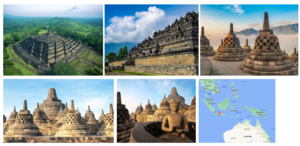In spite of its significance and world impact over the last two millennia, Buddhism isn’t the majority religion in very many countries these days. Bhutan, Myanmar (Burma), Cambodia, Sri Lanka, Thailand, Mongolia and Laos – that’s about it. Seven countries. Nevertheless, the Buddhist empires of yore have left their mark. A trip to Southeast Asia wouldn’t be complete without a visit to Angkor Wat (Wow Place #39) in Cambodia, or Bagan (Wow Place #9) in Myanmar – two of the world’s greatest Buddhist monuments. Spending a day wandering among the imposing ruins of either of these two sites is a reminder of the religion’s out-sized presence and overwhelming influence in the region.
Curiously, there’s a third great Buddhist site in Southeast Asia that is often over-looked – at least by western visitors: Borobodur. Located in central Indonesia, Borobodur is, in fact, the largest Buddhist temple in the world, not to mention Indonesia’s single most-visited tourist attraction. And yet, how many of you ever heard of it, let alone visited it? I’m guessing not many. I wonder why that is? The place is amazing. Dating back to the ninth century, Borobodur temple consists of nine stacked platforms, six square and three circular, topped by a central dome. It is decorated by 2,672 relief panels and originally, 504 Buddha statues. In its heyday, pilgrims arriving at the temple would start at the base and follow a path around the structure, rising up through three levels of enlightenment: the world of desire, the world of forms and the world of formlessness. Along they way, they’d gain inspiration from the many detailed relief panels accompanying them on their journey, blending Buddhist concepts and the Indonesian indigenous tradition of ancestor worship. Although Buddhist in its overall design, Borobodur is uniquely Indonesian.

As a modern-day pilgrim, I try to re-create the traditional journey during my visit to Borobodur. As I circle the temple, I admire the myriad scenes presented in the panels – the Buddha’s origin as Prince Siddharta, his kindness and sacrifice as he was reincarnated in various forms (human and animal), his good works, his first sermons, and eventually, his preparations for Buddha-hood. Although some of the reliefs are crumbling and indistinct, many are in pristine condition, as if they were carved yesterday, reminding me of the temple hieroglyphics in Luxor, Egypt (Wow Places #96 and #152). Borobodur is one of those places that makes me feel honored to have been allowed to travel around the world. Unlike so many other monuments that celebrate military victories and the way of the warrior, here’s a site dedicated to peace and spiritual development. Especially in our current turbulent times, there should be more memorials like this.
If you ever find yourself on the island of Java in Indonesia, Borobodur is well worth the visit. The Indonesians certainly know about this place; it’s high time the rest of the world did as well.
(As a denizen in the modern world, it’s easy to fall prey to feelings of self entitlement—the state of mind when you believe that you deserve more than you do. Don’t get me wrong; there are times when you have to fight for what’s owed to you. But I believe there’s a place for humility and gratitude in our lives as well. Not everyone has a roof over their heads. Not everyone has a car, an I-pad, a waterpik, not to mention their health and a loving partner/family. These are all gifts, to be recognized from time to time, with thanks and appreciation. What are you grateful for? What makes you feel honored?)
